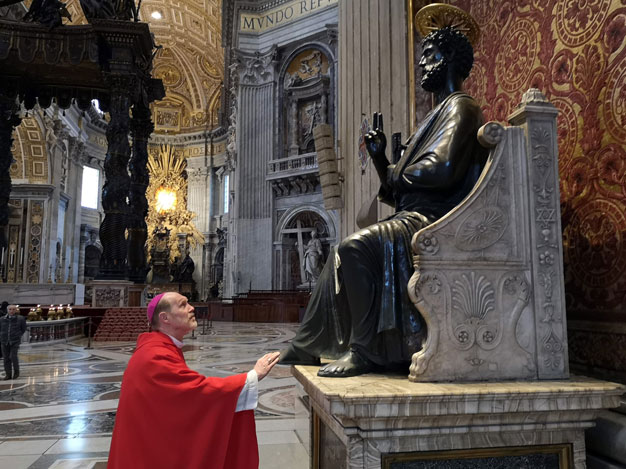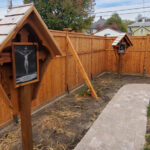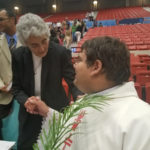
Bishop Thomas Zinkula touches the foot of St. Peter at St. Peter’s Basilica at the Vatican during his recent “ad limina” visit.
By Barb Arland-Fye
The Catholic Messenger
Praying at the tombs of St. Peter and St. Paul. Walking in the footsteps of the apostles. Visiting with Pope Francis for two and a half hours. Talking with Vatican representatives about the Catholic Church. Bishop Thomas Zinkula took in these experiences deeply during his visit “to the thresholds of the apostles” (“ad limina apostolorum” in Latin) to report on the status of the Diocese of Davenport.
Bishops who lead dioceses make an ad limina visit to the Vatican approximately every five years. They journey there in groups, as members of a region. The Diocese of Davenport belongs to Region IX, which covers Iowa, Nebraska, Missouri and Kansas. It was Iowa’s turn to provide the coordinator and Bishop Zinkula accepted the assignment. It was his first ad limina visit.
“For me the ad limina experience was kind of like Marriage Encounter, an ‘Episcopacy Encounter,’ a renewal of vows, a renewal of my episcopal ordination and the renewal of my vocation of bishop. It gave me the opportunity to reflect and pray about my ministry, and to rededicate, recommit myself to it,” Bishop Zinkula said. “Being in Rome and doing what we did gave me a new vigor and energy. It helped me refocus.”
The Region IX bishops celebrated Mass daily and prayed in the four major basilicas in the birthplace of the Roman Catholic Church. They gained a broader perspective of the lived experiences of the universal Church from the curial (governing) offices whose staffs oversee evangelization, faith, family, formation, vocation, catechesis and justice, among other subjects.
He and his fellow bishops spent quality time with Pope Francis, who responded to their questions frankly, listened intently, joked with them and shared stories to make a point. The pope spoke in Italian during the wide-ranging, private conversation and had an excellent interpreter, the bishop said. “I felt totally at ease in the Holy Father’s presence. He was a very gracious and hospitable host. Initially I was a bit nervous being the facilitator of the meeting, but it turned out that it was a fairly easy role.”
They discussed the Vatican’s investigation of the former Cardinal Theodore McCarrick, an accused abuser who has been laicized; and the Church’s stance on defending life from womb to tomb, among other topics. “We talked about some hard things, some challenging issues.” The lengthy discussion precluded a question from Bishop Zinkula. “I wanted to ask, how do we remain joyful and hopeful at such a difficult time in the church? What can we do to help priests and laity to be joyful and hopeful?”
Prior to the visit with the Holy Father, the Region IX bishops celebrated Mass at St. Peter’s Basilica. Father John Lamansky, a priest of the Davenport Diocese, joined them for Mass. While at the basilica, he snapped a photo of Bishop Zinkula kneeling in front of a larger-than-life statue of St. Peter. The toes on one foot of the statue have worn away from pilgrims touching them and reverencing them over the centuries, the bishop said.
Of course, the bishops also made time to enjoy each other’s company, breaking bread together for “pranzo” (lunch) and “cena” (dinner), sometimes with Iowa seminarians studying at the NAC. Thursday night is Iowa night at the NAC, so they joined the seminarians for snacks and conversation that night.
Orientation day
The bishops arrived at the Pontifical North American College (NAC) in Rome on Jan. 12, the Feast of the Baptism of the Lord. Bishop Zinkula and the other bishops celebrated Mass that day and had brunch afterwards with Iowa seminarians at the NAC. Father Lamansky joined the group for brunch.
Later that day, the bishops participated in an orientation session with Father David Schunk, the NAC’s assistant vice-rector. He filled them in on details of things they would do, places they would visit and people they would talk with, including Pope Francis.
During their stay, the bishops would be required to visit four dicasteries (governing bodies): Secretariat of State, Congregation for the Doctrine of Faith, Congregation for Bishops and Congregation for the Clergy. Visits to other dicasteries were encouraged.
First day highlights
On Monday, Jan. 13, following Mass at the Basilica of St. John Lateran, Bishop Zinkula visited the Dicastery for Laity, Family and Life, which Pope Francis established in 2016. Cardinal Kevin Farrell, the prefect, previously served in the U.S.
“A couple of women have significant roles in the dicastery, which was refreshing,” Bishop Zinkula said. They advised the bishops to select lay people to serve as catechists, rather than to simply ask for volunteers, and to invest time and energy in their training. Other messages Bishop Zinkula took away from that visit: help lay leaders to understand their role in witnessing to the faith, seminarians need to be trained to work with laity, priests need to be trained to work with young people. “We need to help people have an encounter with Christ. We need to take another look at our religious education programs. We need to help young people get involved in church. Then they will have more of a desire to know Jesus.”
Also, provide better marriage preparation and accompany married couples in the early years of their marriage. “We need people available to support couples facing difficulties,” the bishop heard. “Form couples so they can form other couples. (Encourage couples to) focus on prayer to put Christ at the center in marriage.”
Bishop Zinkula later attended a meeting with the Pontifical Mission for the Protection of Minors. Discussion covered survivor advisory boards, safety guidelines, definition of vulnerable adult, restorative justice, and appropriate treatment facilities for offenders, among other topics.
Second day highlights
On Tuesday, Jan. 14, the Region IX bishops celebrated Mass at the Basilica of St. Mary Major. “I offered Mass for Archbishop Michael Jackels of the Archdiocese of Dubuque because he couldn’t make it to Rome,” said Bishop Zinkula, adding that St. Mary Major is the archbishop’s favorite basilica in Rome.
Bishop Zinkula visited the Pontifical Congregation for Promoting the New Evangelization where the staff talked about the Fellowship of Catholic University Students (FOCUS) and how that organization’s evangelization efforts could be implemented in parishes. Engagement in works of charity is a beginning point in the evangelization process. “Young people have a longing, but don’t know what they long for,” Bishop Zinkula said. “Our faith can help them find meaning.”
At the Congregation for Bishops, topics included vocations, sharing best practices and collegiality. Bishop Zinkula learned the average age of priests in each of the Region IX dioceses ranges from 47 to 70. “Wichita has had a ton of vocations,” he noted. However, in general, vocations to the priesthood and religious life continue downward.
Catholic education plays an important role in inspiring individuals to consider a religious vocation. Young men typically get inspired during high school; young women, in elementary school. Pope Francis’ 2013 apostolic exhortation “The Joy of the Gospel,” “gives us the framework, the vision to evangelize and to get people engaged in corporal works of mercy.” Evangelization was a common theme throughout the visits, he said.
During a meeting with Cardinal Pietro Parolin, the Vatican’s Secretary of State, the bishops discussed the plight of persecuted Christians, the Catholic Church in China, and the Vatican financial scandal. The cardinal told the bishops that at this point the Holy See is focused on normalizing the role of the Catholic Church in China rather than concentrating on diplomatic relations. Relations between the Vatican and China are better now than in the past. The financial scandal is being adjudicated. Reformation remains a priority.
Third day highlights
Wednesday, Jan. 15, the bishops visited the Congregation for the Doctrine of the Faith. Key takeaways for Bishop Zinkula: The congregation’s role is not just protection of the faith, but also promulgation of the faith. The congregation is making progress on its backlog of old sex abuse cases but could use more canon lawyers to expedite. The congregation also discussed Scripture scholarship to address issues about gender identity.
Fourth day highlights
Prior to their visit with the Holy Father on Thursday, Jan. 16, the bishops visited the Basilica of St. Peter. “That was a highlight for me. We unfortunately didn’t have the opportunity to spend a great deal of time at St. Peter’s tomb. But we celebrated Mass at the Altar of the Tomb of St. Peter, so I was able to be near it and see it throughout the Mass.”
Fifth day highlights
On Friday, Jan. 17, the bishops visited the Congregation for the Clergy. They talked about the need for a propaedeutic stage (similar to a novitiate) for seminarians that focuses on the human dimension of their formation prior to their academic studies. The bishops also talked about mentorship for newly ordained priests and how to help priests struggling in their ministries. Afterwards, the bishops visited the Basilica of St. Paul Outside the Walls, the last of the four major basilicas in Rome they were required to visit.
Reflecting on the ad limina visit, Bishop Zinkula said, “It hits home while you’re there, the importance of the ad limina visit. You give yourself over to it, you experience it and that’s when it really sinks in.”











